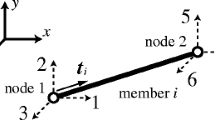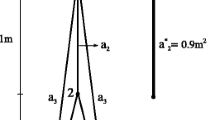Abstract
A mathematical model was developed for layout optimization of truss structures with discrete variables subjected to dynamic stress, dynamic displacement and dynamic stability constraints. By using the quasi-static method, the mathematical model of structure optimization under dynamic stress, dynamic displacement and dynamic stability constraints were transformed into one subjected to static stress, displacement and stability constraints. The optimization procedures include two levels, i.e., the topology optimization and the shape optimization. In each level, the comprehensive algorithm was used and the relative difference quotients of two kinds of variables were used to search the optimum solution. A comparison between the optimum results of model with stability constraints and the optimum results of model without stability constraint was given. And that shows the stability constraints have a great effect on the optimum solutions.
Similar content being viewed by others
References
Sun Huanchun, Chai Shon, Wang Yuefang, Shi Lianshuan. Discrete Optimum Design of Structure[M]. Dalian University of Technology Press, Dalian, 2002, 358–377 (in Chinese).
Sun Huanchun, Shi Lianshuan, Chai Shon. Discrete optimization of structures under dynamical stress and displacement constraints [J]. Chinese Journal of Computational Mechanics, 1997, 14(suppl):723–726 (in Chinese).
Shi Lianshuan, Sun Huanchun, Feng Enmin. A design method for topological optimization of structures with discrete variables under dynamic stress and displacement constraints[J]. Applied Mathematics and Mechanics (English Edition), 2001, 22(7):781–787.
Chai Shon, Shi Lianshuan, Sun Huanchun. An application of relative difference quotient algorithm to topology optimization of truss structures with discrete variables[J]. Struct Optim, 1999, 18(1):48–55.
Chai Shon, Sun Huanchun. A relative difference quotient algorithm for discrete optimization[J]. Struct Optim, 1996, 12(1):45–56.
Li X S. An aggregate function method for nonlinear programming[J]. Science in China, Series A, 1991, 34(1):1467–1473.
Sun Huanchun, Wang Yuefang. A note on the classic theory of stability analysis of truss structures[J]. Chinese Journal of Computational Mechanics, 2005, 22(3):316–319 (in Chinese).
Author information
Authors and Affiliations
Corresponding author
Additional information
Contributed by SUN Huan-chun, Original Member of Editorial Committee, AMM
Project supported by the National Natural Science Foundation of China (Nos.10002005 and 10421002); the Natural Science Foundation of Tianjin (No.02360081); the Education Committee Foundation of Tianjin (No.20022104); the Program for Changjiang Scholars and Innovative Research Team in University of China and the 211 Foundation of Dalian University of Technology
Rights and permissions
About this article
Cite this article
Shi, Ls., Wang, Yf. & Sun, Hc. Approach for layout optimization of truss structures with discrete variables under dynamic stress, displacement and stability constraints. Appl Math Mech 27, 593–599 (2006). https://doi.org/10.1007/s10483-006-0504-y
Received:
Revised:
Issue Date:
DOI: https://doi.org/10.1007/s10483-006-0504-y
Key words
- discrete variables
- structure optimization
- layout optimum design
- dynamic stress constraint
- dynamic displacement constraint
- dynamic stability constraint
- relative difference quotient




